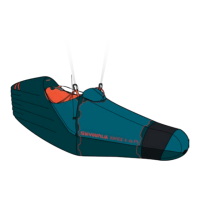Flying Safe 5150 Flying Safe
8 FLYING SAFE
PREFLIGHT CHECK AND MAINTENANCE
It is important to check all paragliding equipment thoroughly before every flight to see
if it has any defects. Also check the paraglider after long flights and after long storage.
Check thoroughly that:
> no visible damage to the harness or carabiners is present that can affect airworthiness.
> the protector is filled and properly closed.
> the reserve parachute container is correctly closed and is connected to the harness, and
that the splints are threaded completely through the loops, and that the rescue handle
is correctly mounted.
> all buckles, straps and zippers are shut and secured. Give each strap a light tug to verify
this. If snow or sand is present, then pay especially close attention.
> the paraglider is correctly hooked to the harness and that both carabiners are correctly
closed and secure.
> the speedbar is properly hooked into the speed system of the risers.
> all pockets are closed and that no loose items are hanging around.
> again, all leg and chest straps are closed before you launch!
CAUTION
DO NOT LAUNCH IF YOU FIND ANY DEFECTS, EVEN SMALL ONES! IF YOU FIND
ANY SIGNS OF DAMAGE OR ABNORMAL WEAR AND TEAR, CONTACT YOUR FLIGHT
SCHOOL OR SKYWALK DIRECTLY.
BEHAVIOR IN THE EVENT OF A RESERVE CHUTE DEPLOYMENT
> Locate the rescue handle and hold it tightly with one hand.
> Pull the handle firmly out and to the side to extract the reserve chute from the container
of the harness.
> Make sure that you throw the reserve chute in the deployment bag into free airspace.
> If possible, throw it in the opposite direction of any rotational movement and let go of
the handle!
> Once the reserve chute is open, try to keep it from tangling and swinging. It is best use
the B-, C- or D-lines or the brake lines to pull the glider symmetrically toward you.
> When you land, straighten up as much as possible and use the parachute landing fall
(PLF) technique to minimize the risk of injury.
WHAT TO DO IN EMERGENCY SITUATIONS AND EXTREME FLIGHT CONDITIONS
Disturbances of the paraglider that are caused by thermal lift or turbulence are transmit-
ted perceptibly via the harness mounts to the seatboard. To avoid getting tipped to the
side, make sure that you are always sitting in the middle of the seatshell. Also make sure
that you don’t lose your grip on the brake handles so that you can react quickly and without
delay to extreme flight conditions. Read about the behavior of your glider in extreme flight
conditions in the appropriate manual. Should you fly into an object or land in a tree, be calm
and notify the authorities.
FLYING ON BAR
The speed bar should be secured to the harness prior to launch. To use the speed bar, you
will need to make some effort. This can affect the sitting position in the harness. Therefore,
we recommend an upright position in the harness. Adjust the harness before your first
attempt of flying on bar. We remind you to only fly in wind conditions that don’t require
constant use of the speed bar. To reach the maximum speed, press the speed bar firm-
ly until both pulleys on the A-risers touch each other. As soon as you apply the speed bar,
the angle of attack will be reduced and the speed increases, but the paraglider becomes
less stable and can collapse more easily. For this reason, always use the speed bar with
adequate altitude over the ground and distance from obstacles and other aircraft.
Avoid adjusting the speed bar too short. It is important to avoid unintentionally activing
the speed system due to a setting that is too short. Collapses on bar are normally more
impulsive and demand fast reactions.
CAUTION
NEVER FLY ON BAR IN TURBULENT AIR.
NEVER FLY ON BAR NEAR THE GROUND.
EN

